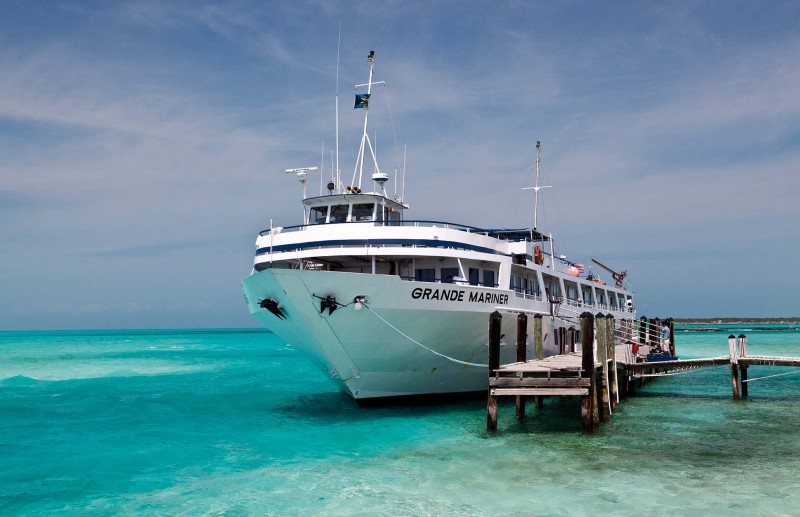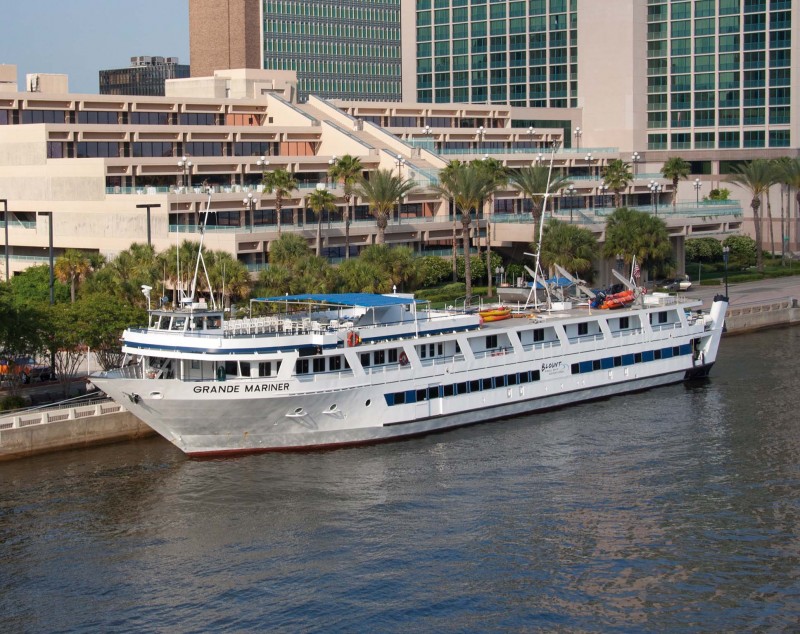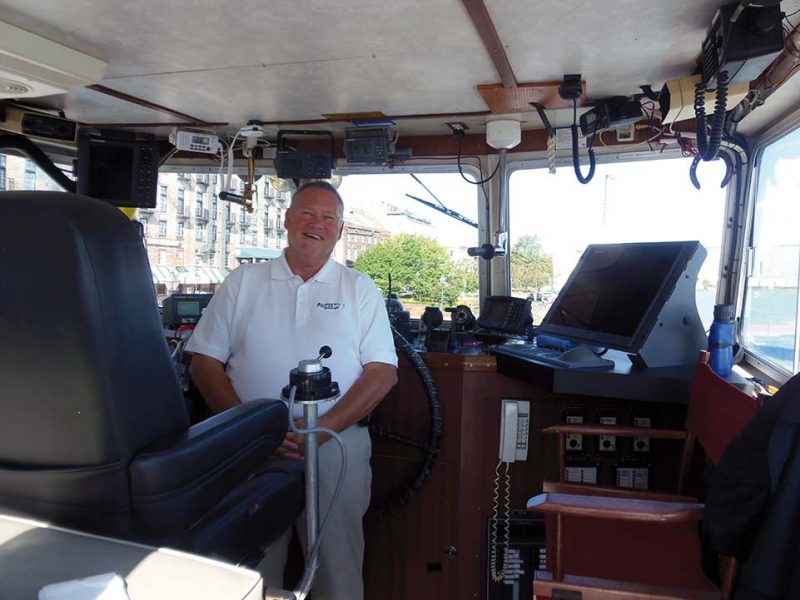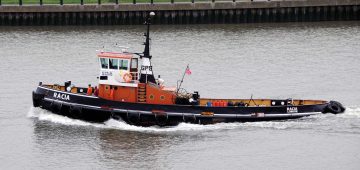by John Martin

The name of ‘Grande Mariner’ no doubt invokes an image of one of the 21st century ‘mega’ cruise ships, but nothing could be further from the truth. It makes one wonder if the original builder, owner and operator (the late Luther Blount) had a mischievous twinkle in his eye when he named her. We might never know, however his five children, who have carried on the family business would no doubt be able to shed some light on his thinking!
What is without doubt is that he created a trio of amazing little cruise ships, all built in his own shipyard at the town of Warren, in the state of Rhode island on the Eastern Seaboard of the USA. It is a town long associated with shipbuilding, a town where clippers and whalers were built in years gone by, which were often owned and crewed by the local townsfolk themselves. The name of Blount is well known in shipbuilding circles in the USA, for the same person built and supplied the first excursion and dinner cruise vessel for Circle Lines of New York. That ship, the ‘Miss Liberty’ became the first to run regular excursions to the Statue of Liberty, and pioneered the idea of the dinner cruise. The family firm has also built a huge variety of different vessels, ranging from 4,500 grt offshore supply vessels, to the smallest of harbour service hulls, and its many clients include the governments of both the USA and Canada.
Luther Blount was an inventor and innovator who had a love of sailing along America’s coasts and river systems himself, so it is no surprise that his experience of building vessels of all shapes and sizes should lead him to consider the advantages of owning his own cruise line. Before he passed on, he was the proud owner therefore of the Grande Mariner, the Grande Caribe and the Niagara Prince, each of which bore the imprint of his own unique shipbuilding methods, and each of which provide a cruising experience unlike no other.
I was a guest on board the Grande Mariner, and joined her in Savannah, that most venerable of South-eastern USA ports, one fine morning in May 2014. I watched as she stemmed the last of an ebb tide, and quietly slid into her berth right beside historic downtown river Street, on the banks of the Savannah River. The ability to go where the large and even small liners cannot is just one of the things that set the ships apart from their more glamorous big sisters, but there is much more to it than that.

Uniquely, the Grande Mariner and Grande Caribe are classified for both domestic and international waters, and so the company finds itself complying not only with the Classification rules of Det Norske Veritas, but also the stringent policies of the U.S. Coastguard and the full range of IMO regulations. Other regulatory issues include the separate and distinctive rules relating to the great Lakes, Canadian and Caribbean territorial waters. Not inconsiderable too are the constraints they face in dealing with local domestic river regulations such as on the Missouri and Mississippi rivers, and the burden of strict labour and employment laws, which mean that the vessels have to employ American citizens as crew at all times. Needless to say this means that ‘Blount Small Ship adventures’ face considerable challenges in order to be competitive with the international cruise market. Captain Mike Keirnan of the Grande Mariner described just one of the problems to me, where the fees charged for some aspects of a port state inspection of his vessel with just 25 crew and eighty passengers were exactly the same as that charged for a cruise ship carrying four thousand passengers and crew! Some of those issues clearly place a large financial burden on the company, and keeping the ticket price competitive remains a challenge each year. Despite this, it is also clearly a cost worth bearing, and the Grande Mariner is crewed by an enthusiastic and dedicated team, some of whom had been with the company for many years. It was also borne out by the large number of repeat customers who mainly hail from either Canada or the USA and regularly join to experience yet another of the many cruise sectors that are available each year.

Luther Blount had a vision, based on his own sailing experience, that there was a need for small but comfortable, full service cruise ships which could explore not only the full extent of the Eastern Seaboard of the USA, but also the great Lakes, the Big rivers, the Caribbean and the Bahamas. He recognised that for his ships to be able to navigate through the Intracoastal Waterway (the inside passage behind the barrier islands that runs the whole length of the Eastern Seaboard), they would have to be of only moderate draft. He recognised that for them to navigate along the length of the canals and rivers there would be times when a minimal air draft would also be called for. He recognised that if he wanted his passengers to have the ability to disembark directly onto a deserted sun kissed Caribbean beach, an unusual bow ramp arrangement would be needed. But Luther Blount was nothing if not an innovative ship builder, and amongst many inventions, he came up with patents for a unique bow ramp/gangway arrangement and a fully retractable navigating bridge.
The Grande Mariner normally carries up to 88 passengers, with a crew of 17 to 25 on board, depending on a number of factors, and when I joined, she was on her ‘Southern antebellum’ cruise, from Jacksonville to Charleston via the ports of St. Augustine, Brunswick, Savannah and Beaufort. Depending on tidal conditions, the Captain will tend to cover most of the route using the Intracoastal Waterway, however, dredging problems and low tides do sometimes mean that the ship will go out to sea, and navigate northwards, as close in as the shoaling and hazards will allow.
Captain Mike Kiernan and Cruise Director Lisa Pontarelli greeted me on the river Street landing stage, and prior to her evening departure for the short trip to Beaufort in South Carolina, I was able to tour the ship and learn much about her operations. The public areas such as the forward lounge and the dining saloon were nicely furnished without being ostentatious in any way, whilst passenger cabins were in general small but comfortable two berth rooms done out with a nautical, clubby theme, complete with private facilities.
Technically, the Grande Mariner is very well equipped to deal with the different environments she finds herself in. Powered by twin screw caterpillar engines and a Cummings bow thruster, she also has twin rudders and two backup generators. on the small navigating bridge, she has a full suite of Furuno navigational aids and communications systems, together with ‘Ecdis’ and ‘AIS’ systems, making her as well equipped as passenger vessels many times her size. The uniqueness of all this is that the bridge can be hydraulically lowered to the deck below, the radar and communications masts laid flat and the bridge deck cleared completely within an hour or so, in order for Grande Mariner to pass under low clearance bridges, be they in a canal or river system. This means that the ships can navigate almost completely around a loop which encompasses the Eastern Seaboard, the great Lakes and canals of that area, the ‘Heartland’ river systems such as the Mississippi and the Missouri, the Gulf of Mexico, the Caribbean and the Bahamas.
There is only one bridge in the state of Illinois which prevents the loop being closed for ships of the size of the Grande Mariner, however Captain Keirnan proudly told me that he had in fact only recently completed what is generally known as ‘The great Loop’, by bringing two separate ships ‘bow in’ and overhanging on opposite sides of that final bridge!

It’s not often one gets to see and experience a really unique cruise ship these days, something that offers a missing dimension to a journey by sea. Liners are mostly gargantuan affairs, with a sprinkling of smaller upmarket offerings, all no doubt good to excellent in their own way, but curiously bland and uniform in their modus operandi. What the Grande Mariner and the Grande Caribe offer is the chance to enjoy in comfort an ever changing vista of the north American continent such as will never be experienced by conventional travel means. They offer the opportunity to step ashore onto a beach directly from ship, to disembark into the very heart of an historical old town. They offer the chance to see ‘up close and personal’ the amazing diversity of coastal, river and lake traffic that can be found throughout the many cruise sectors the company has carefully developed over the years. All this from the spacious decks of two fine little cruise ships which are equally at home on both salt and fresh water!



Comments
Sorry, comments are closed for this item